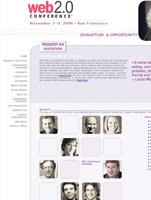The World Wide Web, Take 2
Experts have begun to observe that the online shopping experience may be heading toward a new paradigm as e-tail giants eBay, Yahoo! and Amazon increasingly deliver more dynamic content customized to a user’s preferences.
The concept is similar to a format called RSS (Really Simple Syndication), which only delivers information of interest to the user and, in so doing, creates virtual communities, or affinity groups.
These and other new server-side technologies that favor personalization and community- relevant content over the old broadcast model, which sends the same message to everyone, now are sharply redefining current advertising and revenue models.
In addition, efforts are well underway to make today’s most popular Web browser— Mozilla’s Firefox, available at no cost to Mac and PC users—into a genuine two-way communications tool, with shopping built-in as one of a variety of automatic functions.
Of course, reinventing the World Wide Web is a lofty notion that’s been widely circulated since last year, when the term “Web 2.0” suddenly came into vogue in high-tech circles, even though few agree on its definition.
The excitement that launched the Web into the popular medium it has become is not only coming back but also spreading like wildfire. That’s why more than 800 techies—at $2,800 a head, no less—recently crowded the sold-out Web 2.0 Conference in San Francisco—to begin to get a feel for the shape of things to come and launch a flood of deal-making and venture capitalizing.
Web 2.0, according to conference sponsor Tim O’Reilly, “is an architecture of participation based on social software, where users generate content rather than simply consume it, and on open programming interfaces that let developers add to a Web service or get at data.”
The popular Web-based encyclopedia Wikipedia’s current definition of Web 2.0 is “a term often applied to a perceived ongoing transition of the World Wide Web from a collection of Web sites to a full-fledged computing platform serving Web applications.”
Ross Mayfield, CEO of SocialText, a company that sells collaborative software to enterprises, had a simpler definition for conference goers: “Web 1.0 was commerce. Web 2.0 is people,” he said.
So, does this mean that a whole new Internet is about to replace the old one?
No. Web 1.0 will still be here, but the focus will shift from the user’s desktop to subscribing to and participating in services provided by the Web, many of which will be offered at no cost. “The Web is the platform, not your desktop” is the new mantra.
In Web 2.0, commerce will take a back seat. These yet-to-be invented communityoriented sites will include lots of merchandise for sale, but shopping will be an incidental feature, not the primary one. This is not to say there will be any decline in sales volume— in fact, it should increase. The sell will just be softer, more natural.
Web 2.0 will look and behave much differently than today’s Web, hence the distinction. Retailing will rise to new forms and formats. Branding will assume new dimensions and significance. And shopping will look and feel implicitly convenient and more integrated with life and other online activities to the extent that it may often not even be perceived as such. A brave new world of seamless integration awaits.
Site review: E-tail veteran
Girlshop.com, along with its companion guyshop.com and totshop.com, is a shopping site for emerging designers and cool finds that has a personality and point of view.
“Eight years ago there was nothing like it on the Web,” said its founder and chief executive officer, Laura Eisman, who realized at the time that most stylish women across the country had limited access to up-and-coming talent, let alone a female-friendly site they could visit for a compelling fashion experience.
Todd Richter, her business partner and husband, has his own software development company from which he supplied the technical support and software. Together they built Girlshop, creating one of the first fashion retailers on the Internet. They also opened a bricks-and-mortar companion store in New York last year.
Almost a decade later, Girlshop continues to give shoppers a fun and inspiring online experience, ranging from style icons such as Iman and Lindsay Lohan, to editors always on the lookout for the latest, to a personal shopper on call to offer fashion suggestions and style tips.
Cutting edge yet still approachable, Girlshop gives invaluable exposure to the more than 75 indie fashion lines it carries, including up-and-comer Mike & Chris, celebrity favorites J Brand jeans and ingwa; melero.
Designers are carefully selected through an ongoing submission process and cover a range of price points and age groups.
The site, a slick combination of photos and cartooned illustrations, sells its wares by efficiently presenting lots of items, most with discounted price tags, and then getting the visitor to the shopping cart ASAP.
Each designer is presented in a mini boutique, and the founders say they are always interested in viewing new lines and products. Fashion, accessory and product designers need to simply submit photos and wholesale price information as outlined on the site.























